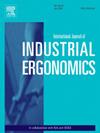Sedentary behavior and musculoskeletal symptoms among work from home employees
IF 3
2区 工程技术
Q2 ENGINEERING, INDUSTRIAL
International Journal of Industrial Ergonomics
Pub Date : 2024-11-01
DOI:10.1016/j.ergon.2024.103653
引用次数: 0
Abstract
Work from home (WFH) may result in less physical activity and more sedentary behaviour among office employees. The consequence to body pain is unknown. The aim of this study was to assess longitudinal sedentary behaviour change and pain association among office workers who have been working from home. Baseline survey was administered to a cohort of office employees in January–February 2020. In March, all employees started to work from home in response to the COVID-19 pandemic. The additional surveys took place in April, June, and December 2020. The survey consisted of IPAQ, which included sitting time report, along with self-reported proportion of time spent standing during work, and body pain. Generalized estimating equations were used to analyse the trends in pain scores, and their associations to sitting time and standing frequency. The cohort consisted of 143 participants at baseline. Participants reported lower pain scores for neck (risk ratio = 0.90, CI = 0.82–0.99) and back (risk ratio = 0.85, CI = 0.75–0.96) in December, compared with pain scores at baseline. Neck pain among participants with more standing was lower than those with infrequent standing (risk ratio = 0.87, CI = 0.79–0.96). Weekly sitting time had no statistically significant effect on body pain scores. For WFH employees, more standing appears to have a significant protective effect on the neck. Being more sedentary during work does not have a clear detrimental effect on long-term musculoskeletal health.
在家工作员工的久坐行为和肌肉骨骼症状
在家办公(WFH)可能会导致办公室员工的体力活动减少,久坐行为增多。其对身体疼痛的影响尚不清楚。本研究的目的是评估在家工作的上班族的纵向久坐行为变化和疼痛关联。2020 年 1 月至 2 月,对一批办公室员工进行了基线调查。3 月,为应对 COVID-19 大流行,所有员工开始在家工作。附加调查分别于 2020 年 4 月、6 月和 12 月进行。调查内容包括 IPAQ,其中包括坐姿时间报告、工作期间站立时间的自我报告比例以及身体疼痛。采用广义估计方程分析疼痛评分的趋势及其与坐立时间和站立频率的关系。研究组共有 143 名基线参与者。与基线时的疼痛评分相比,参与者在 12 月份的颈部(风险比 = 0.90,CI = 0.82-0.99)和背部(风险比 = 0.85,CI = 0.75-0.96)疼痛评分较低。经常站立者的颈部疼痛低于不经常站立者(风险比 = 0.87,CI = 0.79-0.96)。每周坐着的时间对身体疼痛评分没有明显的统计学影响。对于全职工作的员工来说,多站似乎对颈部有明显的保护作用。工作期间久坐对长期肌肉骨骼健康没有明显的不利影响。
本文章由计算机程序翻译,如有差异,请以英文原文为准。
求助全文
约1分钟内获得全文
求助全文
来源期刊
CiteScore
6.40
自引率
12.90%
发文量
110
审稿时长
56 days
期刊介绍:
The journal publishes original contributions that add to our understanding of the role of humans in today systems and the interactions thereof with various system components. The journal typically covers the following areas: industrial and occupational ergonomics, design of systems, tools and equipment, human performance measurement and modeling, human productivity, humans in technologically complex systems, and safety. The focus of the articles includes basic theoretical advances, applications, case studies, new methodologies and procedures; and empirical studies.

 求助内容:
求助内容: 应助结果提醒方式:
应助结果提醒方式:


